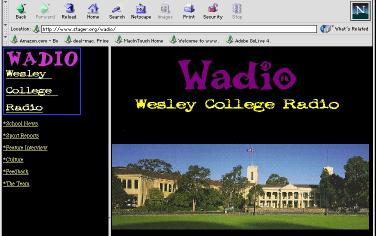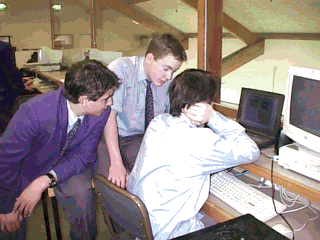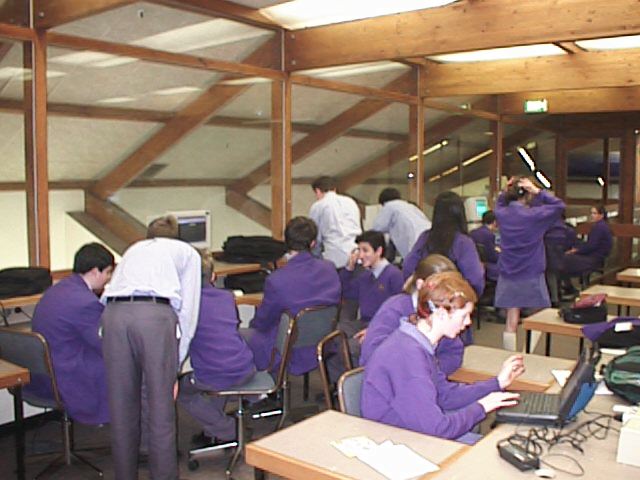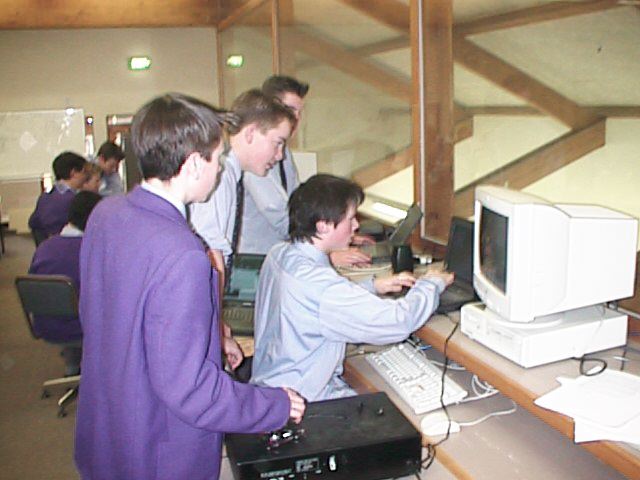WADIO
Published in the November/December 1998 issue of Curriculum
Administrator

© 1998 - Gary
S. Stager

“Put on your virtual helmet and goggles! I’ve never tried this before
and have no idea if we will be successful.” These cautionary words began
my recent work with thirty-two eighth through tenth graders at Melbourne,
Australia’s Wesley College.” I then explained to the unsuspecting
students that we would spend the next four hours producing and broadcasting
a digital radio program on the World Wide Web.
Radio provides a terrific vehicle for the development of writing, editing
and oral communication skills without all of the technical vagaries associated
with video production. Great radio requires great writing and RealAudio provides
remarkably high transmission quality over the inadequate bandwidth found in
most schools and homes. Low-cost digital technology allows every classroom
to be a radio station.
We began the session with a discussion of the advantages of streaming audio
over traditional downloading and a bit about what compression is. Next, we
brainstormed what sorts of information should be included in our school radio
station. The kids determined that there should be school news, sports, music,
movie and book reviews (later grouped as culture), feature interviews and
a public opinion poll included in the broadcast.
 |
I asked for five volunteers to comprise the team of web monkeys I anticipated
would be needed to make everything work on the web. There were plenty
of volunteers. (It seems that the more pejorative the title, the more
workers you can attract.) We then asked kids to sign-up for the reporting
team of their choice, trying to evenly distribute the students.
My next instructions to the teams consisted of, “decide what sort of information
you are going to broadcast, plan, write and record your piece of the program
within the next hour.” The students displayed enormous maturity and self-direction
in their efforts to decide how to make their piece of the program relevant and
interesting. Many of them dispersed so they could conduct a poll, interview or
collect other information on the campus. Their cooperative skills were tested
when we were only able to find one audio tape recorder on the entire campus.
Despite these obstacles, audio tapes poured in after morning tea. |
While the newly formed teams of producers, writers, directors and reporters
fanned out across the campus, the web monkeys went to work. The first dilemma
facing us was that I (the teacher) didn’t know how to stream audio
files over the World Wide Web. I knew I had to use metafiles, but were
not sure
how they worked. Five copies of the documentation were made so I could
ask my young colleagues to help me figure out the correct process. It
didn’t
take long before the idea of metafiles made sense. After overcoming that
hurdle
two kids began designing the web pages needed to contain the broadcast,
while the others downloaded tools they would need to digitize and compress
the audio.
The rest of the team connected an audio deck to the computer and adjusted
audio recording levels in anticipation of the arrival of the tapes. Kids
even
went out and snapped digital photos to include in the web site.
| Things got a bit hectic when the reporting teams arrived with tapes
in-hand. There seemed more than enough work to keep all thirty-two kids
busy. One of the web monkeys quickly became dissatisfied with the quality
of the school’s desktop computer so he took out his personal laptop
and headphones and announced that he would digitize and compress all
of the audio clips. A system for naming files was created, communicated
and documented so everyone would be on the same page. Another member
of the team cut, paste, saved and uploaded meta files to the appropriate
server. While two kids continued designing the web site and one student
took the initiative to be project manager for the entire process. He
demonstrated extraordinary poise and leadership skills while keeping
track of tapes, file names and quality control. I was able to bark shorthand
instructions to him and he would ensure that the relevant people carried
out the task. |
 |
By the end of the four hours a Wesley College School broadcast prototype
was up and running on the web. We decided earlier in the day to call it
WADIO.
A bit less chaos, more time and more experience would have allowed all of
the audio files to sound great. However, the kids did a remarkable job
in
a very short period of time. Their creativity, technical fluency and collaborative
skills continue to inspire me. One group figured out that they could dub
their
music reviews over clips from the CD. The feature interview group decided
that “everyone interviews the principal” so they proceeded to
interview one of the cleaners and “tuck shop” (cafeteria) ladies.
The most pleasant surprise was found on the culture page. The students
not only reviewed
popular music CDs and movies, but included an excellent review of George
Orwell’s
“Animal Farm.” Trusted with responsibility for their own learning,
kids will often exceed our curricular expectations.
None of this would have been possible if the students did not possess the
computing fluency that comes from each student having a personal laptop computer.
It was easy to forget that I was working with kids as I asked them to find
and download programs on the Internet, digitize and edit audio files, create
web pages and upload all of their work to a remote file server. All of these
seemingly complex processes were within the reach of these 13-16 year-olds.
 |
A
few lessons emerged for teachers and administrators concerned with managing
technology and locking down computers.
- The students were able to produce a simple, yet technically complex
streaming audio broadcast on the web in less than one school day.
Perhaps existing models of computer literacy need to be reconsidered.
- The entire product was created with free and shareware tools.
- Despite a zillion dollars worth of school networking, the voice
of Australian students was streaming from a server I pay $5/month
for in Virginia, USA. Much of our email and web services could be
subcontracted externally.
- Thirty two teenagers had access to my personal server password at
all times. I never once feared that they would breach that trust for
I treated them with respect and they were too busy being productive
to be destructive. If the kids had violated my security, I could easily
restore my files and change passwords. They are just computers.
- Information wants to be free. The immediate reaction of some school
personnel was that the broadcast would run better if it were on the
school’s Intranet. This is a big mistake. Kids should have as
big an audience for their work as possible. Parents might want to
listen from work. Students might want to know what time the football
game starts from home and students on distant shores might be inspired
by the work of peers halfway around the world.
- When involved in an purposeful educational project, students will
remain engaged and create a quality of work that exceeds our expectations.
|
|
|
 |
|
|
|
|
|
For more information on creating classroom-based radio programs, the tools needed
and a sample of WADIO, point your browser to http://www.stager.org/wadio/.
WADIO, WWADIO and WWWADIO are pending trademarks of Gary S. Stager
|






